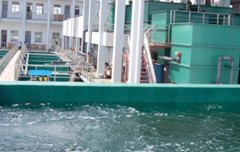Electroplating wastewater is the wastewater produced in our electroplating production.The sources of electroplating wastewater are generally:
(1) Cleaning water for plating parts;
(2) Waste electroplating solution;
(3) Other wastewater, including washing the floor of workshop, washing the plate, condensate of ventilation equipment, and various bath solutions and drainage caused by leakage or improper operation management of plating bath;
(4) The cooling water of equipment is not polluted except for the temperature rise during the use.The quality and quantity of electroplating wastewater are related to the process conditions, production load, operation management and water use mode.The quality of electroplating wastewater is complex and its components are not easy to control. It contains heavy metal ions such as chromium, cadmium, nickel, copper, zinc, gold, silver and cyanide, and some of them are highly toxic substances that cause cancer, teratogenesis and mutation.
Electroplating wastewater is often treated by biochemical method + chemical coagulation method and iron carbon micro electrolysis. In the process of biochemical treatment of electroplating wastewater or chemical addition of coagulant (lime + polyferric sulfate, etc.), it often occurs that the bleaching mud of biochemical tank is seriously black, or the wastewater of secondary sedimentation tank is a large amount of black. What is the reason?How to solve it?
Reasons for black electroplating wastewater.
1. If polymerized ferric sulfate is added in the process of chemical coagulation, the reason why the wastewater appears black should be that it reacts with the sulfide in the wastewater to form iron sulfide. The black insoluble matter of iron sulfide will cause the effluent to blacken and appear as waste water under the action of light scattering, it is very dark. The solution is to add lime to treat the sulfide first, and then add coagulant.
2. After adding polymerized iron sulfate to the wastewater, a large number of 3-valent iron ions are produced. The wastewater is converted into 2 valent iron by reaction of iron powder in the process. In the process of alkali addition and alkalinity adjustment, brown black ferrite will be produced, leading to black wastewater.
Reasons for sludge floating and blackening in biochemical tank
1. The reason for blackening of biochemical tank is usually sludge aging and death, which leads to the presence of black floating mud due to the presence of a large amount of dead mud in the effluent process.Solution: if there is black dead sludge in the aeration tank, it is necessary to increase the sludge discharge and control the sulfate load.
2. When the activated sludge is anoxic, the scum produced is thin and black.It can be further judged by controlling the do value, and the phenomenon of large amount of scum can be alleviated by strengthening reflux.
3. If it is caused by hypoxia or anaerobic caused by insufficient do in sludge, the scum is stacked and black. There is no activated sludge protozoa in the microscopic examination of this scum, the sludge sedimentation is poor and dispersed, and the supernatant is turbid and dark.It can be treated by increasing dissolved oxygen.
4. However, if the scum is brown and piled up excessively, the microscopic examination of SVI and SV can be used to judge whether it is filamentous bacteria expansion.However, if these accumulated sludge can drop rapidly after stirring, it may be the problem of activated sludge denitrification.For this problem, it is necessary to ensure that the carbon source in the water is sufficient and the do value is greater than 3mg / L.








 Mar. 08, 2022
Mar. 08, 2022 





